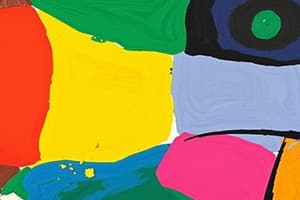Podcast
Questions and Answers
What is the primary focus of art history?
What is the primary focus of art history?
- Cultural interpretations of art
- Chronological development of art forms and styles (correct)
- The subjective experience of artworks
- Individual emotional responses to art
How does art appreciation differ from art history?
How does art appreciation differ from art history?
- It focuses on subjective experience and emotional response (correct)
- It is more research-oriented
- It studies cultural impacts of art
- It analyzes artists' significance
Which assumption about art suggests it transcends cultural barriers?
Which assumption about art suggests it transcends cultural barriers?
- Art involves experience
- Art is universal (correct)
- Art is subjective
- Art is cultural
Which type of visual art combines height and width but lacks depth?
Which type of visual art combines height and width but lacks depth?
What forms does visual art engage to evoke ideas and emotions?
What forms does visual art engage to evoke ideas and emotions?
What technique in 2D visual arts involves reproducing artwork on various materials?
What technique in 2D visual arts involves reproducing artwork on various materials?
Which of the following can best describe the relationship between art and culture?
Which of the following can best describe the relationship between art and culture?
In the context of visual arts, what does the term 'dimension' refer to?
In the context of visual arts, what does the term 'dimension' refer to?
What aspect of art does the term 'Sources of Subject' encompass?
What aspect of art does the term 'Sources of Subject' encompass?
Which of the following examples best illustrates the 'Symbolic' level of meaning?
Which of the following examples best illustrates the 'Symbolic' level of meaning?
Which of the following is NOT a source of subject in art as defined?
Which of the following is NOT a source of subject in art as defined?
What does 'Literal' meaning in art refer to?
What does 'Literal' meaning in art refer to?
What is an example of 'History' as a source of subject in art?
What is an example of 'History' as a source of subject in art?
Which level of meaning in art emphasizes the personal experiences and beliefs of the viewer?
Which level of meaning in art emphasizes the personal experiences and beliefs of the viewer?
In the context of art, what does the term 'Content' primarily refer to?
In the context of art, what does the term 'Content' primarily refer to?
Which of the following captures the essence of 'Nature' as a source of subject in art?
Which of the following captures the essence of 'Nature' as a source of subject in art?
What is the primary characteristic of three-dimensional art?
What is the primary characteristic of three-dimensional art?
Which of the following best describes the social function of art?
Which of the following best describes the social function of art?
According to Plato, how does he view the relationship between art and truth?
According to Plato, how does he view the relationship between art and truth?
What is a key aspect of installation art?
What is a key aspect of installation art?
In which way does Aristotle differ from Plato regarding art?
In which way does Aristotle differ from Plato regarding art?
Which of the following best exemplifies the physical function of art?
Which of the following best exemplifies the physical function of art?
Which philosophical perspective might suggest excluding art from society?
Which philosophical perspective might suggest excluding art from society?
What is the main goal of an artist when creating a self-portrait?
What is the main goal of an artist when creating a self-portrait?
What is the primary purpose of art according to Aristotle?
What is the primary purpose of art according to Aristotle?
How does Kant differentiate between subjective and aesthetic judgments in art?
How does Kant differentiate between subjective and aesthetic judgments in art?
What is the belief of Leo Tolstoy regarding the role of art?
What is the belief of Leo Tolstoy regarding the role of art?
Which of the following types of art does NOT depict recognizable objects?
Which of the following types of art does NOT depict recognizable objects?
According to Aristotle, how does tragedy like 'Oedipus Rex' contribute to the understanding of human experience?
According to Aristotle, how does tragedy like 'Oedipus Rex' contribute to the understanding of human experience?
What distinguishes representational art from non-representational art?
What distinguishes representational art from non-representational art?
What is a key characteristic of Kant's concept of 'disinterested judgment' in art appreciation?
What is a key characteristic of Kant's concept of 'disinterested judgment' in art appreciation?
What underlying theme does Tolstoy’s work convey regarding human emotions?
What underlying theme does Tolstoy’s work convey regarding human emotions?
Flashcards are hidden until you start studying
Study Notes
Assumptions and Nature of Arts: Creativity, Imagination
- Art history and appreciation differ: history studies the evolution and impact of art; appreciation focuses on subjective experiences and emotional connections with artworks.
- Art is universal, expressing emotions and ideas that resonate across different cultures, reflecting shared human experiences such as love and struggle.
- Art is cultural, shaped by society's beliefs and values, with unique forms and styles derived from various cultural contexts.
- Art involves personal experience, engaging both artists and viewers emotionally and stimulating the senses.
Visual Art
-
2D Visual Arts: Limited to height and width, seen in flat surfaces.
- Painting: Utilizes pigments to depict scenes, emotions, or concepts.
- Drawing: Employs tools like pencils or charcoal, ranging from realistic to abstract.
- Printmaking: Involves techniques such as etching and screen printing for reproducing images.
-
3D Visual Arts: Incorporates height, width, and depth in tangible forms.
- Sculpture: Crafts intricate figures from materials like stone or metal.
- Architecture: Focuses on designing and building structures.
- Installation Art: Large-scale works tailored for specific spaces using varied materials.
Functions of Art
- Physical Function: Tangible value in everyday objects with artistic qualities, e.g., artist-designed furniture.
- Social Function: Addresses public issues, fostering community dialogue through art forms like murals.
- Personal Function: Allows artists to express identity and emotions, e.g., self-portraits providing introspection.
Basic Philosophical Perspectives
- Art as Imitation: Plato claimed art represents imperfect copies of ideal forms and distracts from true knowledge.
- Art as Representation: Aristotle viewed art as a means to unveil truths and explore realities, offering pleasure and teaching life lessons.
- Art as Disinterested Judgment: Kant emphasized an objective approach to beauty in art, focusing on universal aesthetic qualities rather than personal preferences.
- Art as Communication of Emotion: Tolstoy argued that art conveys emotions, uniting people through shared feelings and experiences.
Subject and Content
-
Subject Types:
- Representational Art: Realistically depicts recognizable subjects; e.g., portraits, landscapes.
- Non-representational Art: Uses abstract forms to evoke feelings; e.g., Abstract Expressionism, Surrealism.
-
Sources of Subject:
- Personal Experiences: Art reflects the artist's life events, emotions, and memories.
- Nature: Captures the beauty and elements of the natural world.
- History: Documents events and themes, providing insights into past societies.
Content in Art
- Content refers to ideas, emotions, and narratives conveyed through artists' techniques, shaping viewer impact.
Levels of Meaning
- Literal: Direct depiction or narrative; e.g., a bowl of fruit represents fruit.
- Symbolic: Use of symbols to represent deeper concepts; e.g., a red rose symbolizes love.
- Personal: Interpretation influenced by individual experiences and beliefs; e.g., abstract paintings may evoke varied meanings depending on the viewer's background.
Studying That Suits You
Use AI to generate personalized quizzes and flashcards to suit your learning preferences.




